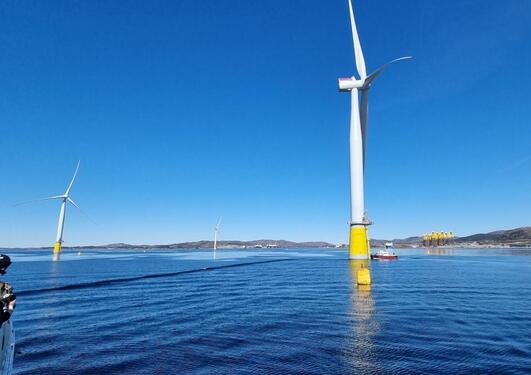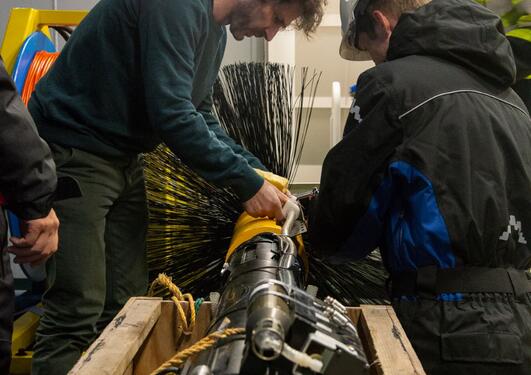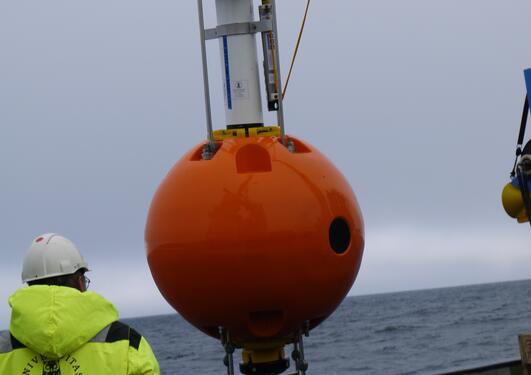News archive for Meteorology
Offshore wind farms can “steal” the capacity of other farms by up to 20 percent up to 50 kilometres away, due to wake loss. The regulation is ambiguous and needs to be developed to accommodate large-scale offshore wind development in the North Sea and other ocean areas, according to PhD Candidate Eirik Finseraas at the Faculty of Law, University of Bergen.
Offshore Wind 2040 (OW2040) is on track to become a Centre for Environment-friendly Energy Research (FME) by the end of 2024. If the Research Council of Norway approves the FME application, OW2040 could become a world-leading hub for offshore wind development.
HRH Crown Prince Haakon of Norway visited the Bjerknes Centre to learn more about our research – and to check the snow he sampled himself in Greenland last summer.
With a prestigious grant from the ERC, Cristian Guillermo Gebhardt plans to solve key issues within offshore wind with smart algorithms and raw computer power.
The circulation in the North Atlantic Ocean can dampen temperature increase and ice melt in certain decades. Researcher warns against interpreting reduced temperature increase as a sign of a slow-down in climate change.
In a large scale airplane campaign researchers will – for the first time – follow water molecules from they take off from the ocean until they have landed as rain or snow in Norway.
Clemens Spensberger's research aims to drastically improve prediction of weather incidents, by describing and establishing climate links between different geographical regions.
Neste uke inviterer Erica Madonna både menn og kvinner til å diskutere om like muligheter i forskningen.
Observations north of Svalbard reveal a pathway of energy transfer from tidal currents to turbulent mixing.
The structure and transport of the slope current at the Lofoten Escarpment are described for the first time using 14-month long mooring records.
Four SDG14 targets are maturing in 2020 and with the University of Bergen's leadership in ocean science and sustainability, the university will take these targets to decision-makers over the course of the upcoming year.
The yearly lecture at the Norwegian Academy of Letters and Sciences.
In the mid-latitudes the weather changes quickly. Changing winds influence the heat exchange between the atmosphere and the ocean. A new study by Fumiaki Ogawa and Thomas Spengler shows how important it is to consider short-term phenomena like extratropical cyclones and cold air outbreaks when calculating air-sea fluxes. Read their account below.
In a number of European countries, there is a clear imbalance between long-term disaster risk reduction and short-term preparation, according to a new study. With increasing amounts of data, there is a potential for investments in long-term reduction measures, but data availability is not enough. Jenny Sjåstad Hagen, co-author of the study, writes about the importance of data interoperability.
What are our safe operating spaces for the ocean? This is the starting question for the new EU Horizon 2020 project COMFORT.
The location of the jet stream influences European weather at all times. A new study links its position both to local weather systems and to the far-away Pacific Ocean. Lead author Erica Madonna explains.
How can the academic community make an impact to get vital information on climate change across to decision-makers? By engaging in the type of quiet science advice provided by Benjamin Pfeil and his team at the University of Bergen.
Pages
- October 2023 (1)
- June 2023 (1)
- March 2023 (1)
- January 2023 (2)
- March 2022 (1)
- November 2021 (1)
- March 2021 (1)
- August 2020 (2)
- January 2020 (2)
- November 2019 (1)
- October 2019 (4)
- August 2019 (2)
- July 2019 (1)
- June 2019 (1)
- May 2019 (3)
- April 2019 (2)
- March 2019 (1)
- February 2019 (1)
- January 2019 (4)
- December 2018 (2)
- October 2018 (2)
- September 2018 (2)
- August 2018 (1)
- April 2018 (2)
- March 2018 (2)
- February 2018 (2)
- January 2018 (1)
- October 2017 (2)
- September 2017 (1)
- June 2017 (2)
- April 2017 (1)
- February 2017 (1)
- December 2016 (1)
- November 2016 (1)
- October 2016 (1)
- August 2016 (1)
- June 2016 (1)
- May 2016 (2)
- December 2015 (1)
- November 2015 (1)
- May 2015 (1)
- January 2015 (1)
- October 2014 (1)
- September 2014 (1)
- June 2014 (1)
- March 2014 (1)
- November 2013 (1)
- October 2013 (1)
- August 2012 (1)
- February 2011 (2)
- January 2011 (1)

















